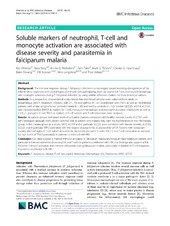| dc.contributor.author | Otterdal, Kari | en_US |
| dc.contributor.author | Berg, Åse | en_US |
| dc.contributor.author | Michelsen, Annika | en_US |
| dc.contributor.author | Patel, Sam | en_US |
| dc.contributor.author | Tellevik, Marit Gjerde | en_US |
| dc.contributor.author | Haanshuus, Christel Gill | en_US |
| dc.contributor.author | Fevang, Børre | en_US |
| dc.contributor.author | Aukrust, Pål | en_US |
| dc.contributor.author | Langeland, Nina | en_US |
| dc.contributor.author | Ueland, Thor | en_US |
| dc.date.accessioned | 2019-06-20T09:38:52Z | |
| dc.date.available | 2019-06-20T09:38:52Z | |
| dc.date.issued | 2018-12-18 | |
| dc.Published | Otterdal K, Berg Ã, Michelsen A, Patel S, Tellevik MG, Haanshuus CG, Fevang B, Aukrust P, Langeland N, Ueland T. Soluble markers of neutrophil, T-cell and monocyte activation are associated with disease severity and parasitemia in falciparum malaria. BMC Infectious Diseases. 2018;18:670 | eng |
| dc.identifier.issn | 1471-2334 | |
| dc.identifier.uri | https://hdl.handle.net/1956/20278 | |
| dc.description.abstract | BACKGROUND: The immune response during P. falciparum infection is a two-edged sword, involving dysregulation of the inflammatory responses with several types of immune cells participating. Here we examined T-cell, monocyte/macrophage and neutrophil activation during P. falciparum infection by using soluble activation markers for these leukocyte subsets. METHODS: In a prospective cross-sectional study clinical data and blood samples were collected from adults in Mozambique with P. falciparum infection, with (n = 70) and without (n = 61) co-infection with HIV-1, as well as HIV-infected patients with similar symptoms but without malaria (n = 58) and healthy controls (n = 52). Soluble (s)CD25, sCD14, sCD163 and myeloperoxidase (MPO) as markers for T-cell, monocyte/macrophage and neutrophil activation, respectively as well as CX3CL1, granzyme B and TIM-3 as markers of T-cell subsets and T-cell exhaustion, were analyzed. RESULTS: All patient groups had raised levels of activation markers compared with healthy controls. Levels of sCD25 and MPO increased gradually from patient with HIV only to patient with malaria only, with the highest levels in the HIV/malaria group. In the malaria group as a whole, MPO, sCD14 and in particular sCD25 were correlated with disease severity. sCD163, sCD25 and in particular MPO correlated with the degree of parasitemia as assessed by qPCR. Patients with falciparum malaria also had signs of T-cell subset activation (i.e. increased granzyme B and CX3CL1) and T-cell exhaustion as assessed by high levels of TIM-3 particularly in patients co-infected with HIV. CONCLUSION: Our data support a marked immune activation in falciparum malaria involving all major leukocyte subsets with particular enhanced activation of neutrophils and T-cells in patients co-infected with HIV. Our findings also support a link between immune activation and immune exhaustion during falciparum malaria, particularly in relation to T-cell responses in patients co-infected with HIV | en_US |
| dc.language.iso | eng | eng |
| dc.publisher | BioMed Central | eng |
| dc.rights | Attribution CC BY | eng |
| dc.rights.uri | http://creativecommons.org/licenses/by/4.0 | eng |
| dc.subject | P. falciparum | eng |
| dc.subject | Malaria | eng |
| dc.subject | T-cell | eng |
| dc.subject | Neutrophil | eng |
| dc.subject | Monocyte | eng |
| dc.subject | Macrophage | eng |
| dc.subject | HIV | eng |
| dc.subject | Parasitemia | eng |
| dc.subject | MPO | eng |
| dc.subject | sCD25 | eng |
| dc.title | Soluble markers of neutrophil, T-cell and monocyte activation are associated with disease severity and parasitemia in falciparum malaria | en_US |
| dc.type | Peer reviewed | |
| dc.type | Journal article | |
| dc.date.updated | 2019-02-01T06:46:01Z | |
| dc.description.version | publishedVersion | en_US |
| dc.rights.holder | Copyright 2018 The Author(s) | |
| dc.identifier.doi | https://doi.org/10.1186/s12879-018-3593-8 | |
| dc.identifier.cristin | 1668357 | |
| dc.source.journal | BMC Infectious Diseases | |

